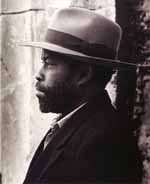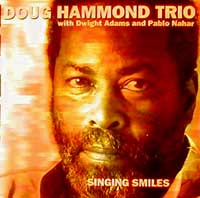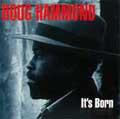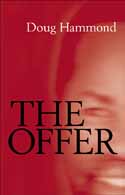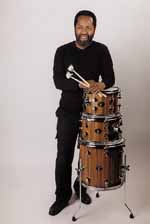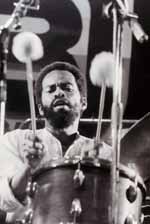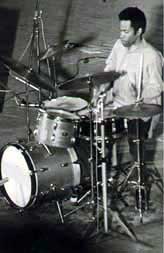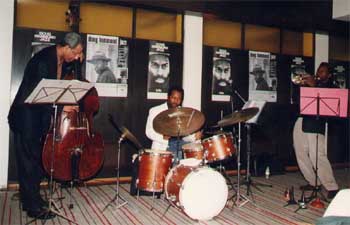 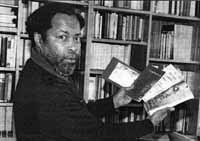
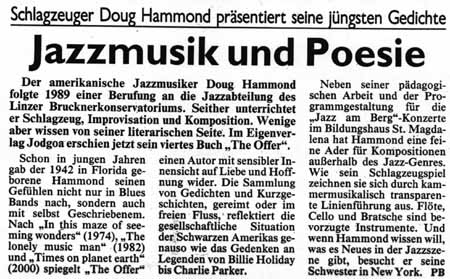
Arikel
aus der Zeitung "Oberösterreich Krone" März 2002
A
Jazz American in Linz
Doug
Hammond: Drummer, Composer, Educator
Doug
Hammond is an American. The colorful Jazz American in Linz. He plays
drums
and is a percussionist. Not a
thunderer,
not a ricocheter, but a thorough support, a crafty signal giver,
straight
ahead and with muscles, sure and singing, sophisticated and naive,
like
it should be in jazz. It was never his intention to drum a siege upon
the
winter
palace of jazz. And no rock morsels either. He is much more a keeper
of
old percussion values - an Enlightened One - far from being a fawning
submission
to the heritage. He's a remover, a refiner, a renewer. Nothing
evaporates,
much evokes: the African-American raw materials; the authority of
a
Baby Dodds, who Armstong gave wings to; all of the higher obligations of
black
swing-giants from Chick Webb to Syd Catlett; the perfection of the
matador
par excellance Max Roach; the potential to be the liberator of the
Free
Era.
Doug
Hammond is also a composer. And as one he is sincerely endeavouring to
formulate
pieces of grand stature. He does things with an earnestness and
then
with a prank. He never leaves the gravitional fiels of swinging, also
as
a
writer.
And he receives awards for his writing. The "Düsseldorf New Music
Ensemble"
performs his pieces, the jazz crew of the highly-praised bassist
Dave
Holland has his works in their program, Charles Mingus' version of his
"Moves"
is documented on the record "Mingus Moves".
Doug
has already long proved his worth as a bandleader in the jazz branch.
With
sax aces Byard Lancaster and Steve Coleman, the pianist Kirk Lightsey
and
the
cellist Muneer Abdul Fataah, he formed a fabulous quintett whose 1982
recording
of "M-Base" have recently been released: "spaces" in the U.S. on
DIW-359,
1992 (CD 9102).
"M-Base"
is probably the most important contemporary cooperation of black
musicians
in the U.S: Cassandra Wilson, Greg Osby, Gary Thomas, Steve Coleman,
Marvin
"Smitty" Smith and various others, these jazz artists, who have already
been
introduced to Linz in concerts, are a part of the whole.
Hammond,
who was born in 1942 in Florida, has been involved throughout his
long
career in bands of Benny Carter, Chet Baker, Sonny Rollins, Charles
Mingus,
Sam Rivers, Sonny Fortune, Mal Waldron, Payuito D'Riviera and
"Family
of Percussion".
[Oberösterreichischer
Kulturbericht, by Robert Urmann, November 1992]
Ohne
aufgesetzte Wildheit die Fans verzaubert
So
souverän wie mit dem Publikum ging er auch mit seinen Musikern um.
Nach ein
paar
freundlich einleitenden Worten setzte sich Doug Hammond an sein
Schlagzeug,
ruhig, gelassen, konzentriert. Allein Hammonds Ausstrahlung
läßt
im
vollbesetzten Amerika-Haus eine Spannung aufkommen, die frei von jeder
Konzerthektik
ist, die man sonst so oft erlebt.
Doug
Hammond ist weder ein eitler Anmacher noch ein selbstverliebter
Kraftprotz.
Nein, die typischen Schagzeugerkrankheiten Angeberei und
aufgesetzte
Wildheit können ihm nichts anhaben. Mit viel
Einfühlungsvermögen
lenkt
er die Improvisation seiner beider Mitstreiter, des Cellisten Muneer
Abdul
Fataah und des Saxophonisten Steven Colman.
Die
Tatsache, daß das Schlagzeug dabei in der Mitte steht,
verdeutlicht
optisch
den musikalischen Ablauf. Hammond ist tatsächlich das Bindeglied
zwischen
den wellenförmig vorgetragenen Temperaturausbrüchen des
gezückten
Cellos
und den sehr modernen, schräg klingenden Saxophonlinien.
Hammond
hält das zusammen, indem er, ausgehend von seinem Herzrhythmus,
den
man
gar
nicht hören, aber spüren kann, auf das allzu einengende
Metrum
verzichtet,
und
nur der freien Form Raum gibt. Hammond verläßt sich einzig
dabei
auf sein
Einfühlungsvermögen.
Er verzichtet auf starre Strukturen und das erweist sich
hier
als Glücksgriff. Dieser Schagzeuger konnte sein Publikumg
verzaubern.
[Berliner
Morgenpost, Sonntag, 2. Oktober 1983 - Seite25]
Doug
Hammond has a new trio...
Ein
Trio, das sich dem Ungewöhnlichen verpflichtet hat.
Frischer
Jazz ohne Verrenkung in Dortmund
Frischen,
unabgegriffenen Jazz mit Blues-Verwurzelung spielte Samstag Abend
das
"Doug Hammond Trio" im "domicil".
Schlagzeuger
Hammond, Trompeter Dwight Adams und Kontrabassist Pablo Nahar
schlagen
eine eigenständige Brücke zwischen Traditionstreue und
Innovation,
die
sie aus dem Mainstream deutlich heraushebt.
Das
Trio kommt dabei ganz ohne gekünstelte Verrenkungen aus. Hammond
spielt
einen
schroffen, expressiven Stil und unterscheidet sich schon insofern von
den
vielen Hochglanz-Virtuosen seiner Zunft. Sein Spiel ist gleichwohl auf
hohem
technischen Niveau, nur spart er sich ein eitles Zur-Schau-Stellen
seiner
Fähigkeiten.
Mit
Adams steht ihm ein ideenreicher Solist mit warmem, flexiblen Ton zur
Seite.
Das typische Blues-Spiel gelingt ihm mit einer nuancenreichen "dirty
intonation",
als Improvisator wählt er oft ungewöhnliche, spannungsreiche
Skalen
und glänzt durch Spontaneität und Stringenz.
Nahar
agiert als temperamentvolle, treibende Kraft. Kunstvoll weiß er
das
Fehlen
eines Harmonieinstruments auszugleichen und geht aufmerksam auf Adams
improvisatorische
Entwicklungen ein. Prägnante Baß-Riffs und reizvolle, oft
ungerade
Metren bilden die Grundlage vieler Stücke.
Die
besondere Qualität des Trios liegt nicht zuletzt darin, daß
nichts
konstruiert
wirkt. Die Solisten ziehen ihre Ideen aus der inneren Spannung von
Chorus
und Thema.
Ein
wirklicher Geheimtip!
[Ruhr
Nachrichten #40, Germany 17. Februar 1997]
|
